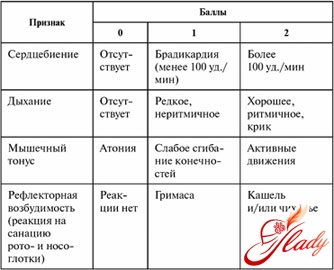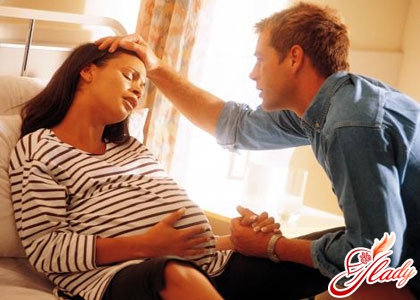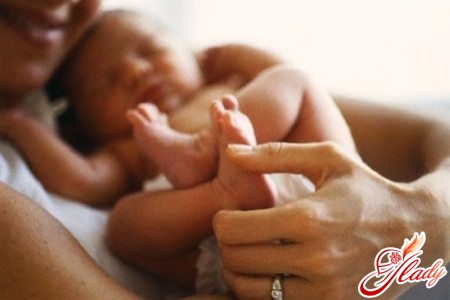 Labor as a physiological process of expulsion of the fetus from the uterus is divided into 3 periods:
Labor as a physiological process of expulsion of the fetus from the uterus is divided into 3 periods:
Disclosure period
The first period is the period of disclosure (expansion,dilation) begins with progressive contractions and ends with the opening of the cervix. The duration of it is individual for every woman in labor: in primiparous women it is usually 9-12 hours, in re-birthdays - 5-7 hours, with rapid birth, this period can be reduced to 2-3 hours. In the process of disclosure, necessary conditions are created to expel the fetus, the cervix is smoothed (or thinned), the outer cervical canal opens, the membranes are torn. Another week before delivery, the cervix is high and directed back; gradually it moves down and forward. In primiparas, a significant degree of smoothing usually occurs before a significant opening of the cervix. In re-births, the cervix of the uterus is usually smoothed and unfolded simultaneously. Smoothing is determined by examining the vagina and is estimated as a percentage. "Zero percent smoothing" - the cervix has not yet begun to thin; "50% smoothing" - the cervix is thinned about half; "100% smoothing" - the neck of the uterus is thinned out completely. Degree of disclosure is assessed on examination and measured in centimeters. When the cervix is open only for the thickness of the finger, it is 1 cm, on average - about 5 cm and at full opening - 10-12 cm, the head of the fruit (the largest part of the fetus) may well pass through such a hole. The main expulsive forces - fights, arise irrespective of the will of the mother in childbirth and proceed involuntarily under the control of hormonal and other physiological factors. Contractions continue intermittently during all births, shortening the muscle fibers of the uterus body and stretching the cervix. Each contraction passes through a wave: it reaches a peak, then gradually weakens, allowing the uterus to rest for a while. At the beginning of labor, labor can be felt as a dull back pain or as menstrual pain. These initial fights are usually (but not always) short and not strong, lasting from 30 to 40 seconds with an interval of 15-20 minutes. Some births, however, begin with frequent and sufficiently violent contractions. With the development of the birth process, you will feel contractions more in the abdomen, or in the abdomen, and in the lower back, and pain in the lower back may not pass between the fights. By the end of the first period the bouts are usually very intense and last for 90-120 seconds with an interval of only 2-3 minutes. The quality of the fights (intensity, duration) is estimated with the help of special devices - monitors, which, in addition to the rates of labor, register the frequency of fetal heartbeats. If there is no monitor, the bouts are simply counted, determining their duration and the intervals between them by the stopwatch, and their strength - according to the stress of the uterus during the fights, putting a palm to the belly of the pregnant woman. By the time of full disclosure of the uterus, an amniotic fluid is usually opened and the front waters leave. The first period of labor consists of three phases: latent, active and transitional. Each phase has its own physiological and emotional characteristics. The latent phase is the longest, the contractions are less frequent and less intense than in the subsequent phases. The neck is smoothed and opened 2-4 cm, possibly 5 cm. During this time it is better not to be alone, try to calm down and distract yourself with something. Talk to a friend, listen to music, etc. There will come a time when you can not be distracted from the fights anymore - their frequency increases. Try to breathe more slowly, it's time to go to the hospital. Active phase - fights become painful, but tolerable, last for a minute or more with an interval of 3-5 minutes. There is no way back, only forward, to the completion of the process. You are increasingly concentrating on your battles, progress may seem too slow, and the forces for fights are required more and more. Your confidence and optimism can restore the news that you are moving into a new state. You are already in the delivery room, try to get comfortable. You can try pressure and cold on the lower back or hot compress on the lower abdomen, groin and lower back. But it can be decided by a doctor or midwife. Go to the toilet once an hour, because a full bladder causes discomfort and slows down the contractions. Change the situation often, unless you are very tired and need rest or if the fights do not follow one after another so often that you do not have time to move; try to walk and sit, and not lie in bed. Some women make the mistake of staying motionless in bed during all births. Lying can increase the painfulness of labor and slow the development of labor. Use the help of gravity, standing or walking for a while. You can alternate activity with rest. It is important to get a liquid, so drink something after every contraction or suck on the lollipops. Your progress is assessed by smoothing and revealing the cervix, as well as moving the baby. Now the most important thing is to relax, during battles, try not to strain especially, breathe slowly. Continue calming and breathing exercises. Now is the right time to get the maximum support from your partner who can praise your efforts, rub your back and legs, count down every 15 seconds of the fight, remind you to move, give water and see you off to the toilet. Relaxation now is the most important thing. Especially try not to strain during labor. You better continue to breathe slowly until it helps to relax. If breathing becomes difficult, if you can not breathe slowly or can not concentrate on breathing and relax even after repeated attempts, switch to superficial breathing. This can give you extra strength. The transition phase is the most difficult for most women giving birth. Contractions are more frequent and longer, pressure on the pelvis is greater, and physical and emotional experiences are stronger. The cervix is opened for the last 1 or 2 centimeters, the head of the child leaves the uterus and is squeezed down into the birth canal, and the child passes into an embarrassing period. A relatively short transition phase usually lasts from five to twenty fights. These fights, the longest for the entire period of delivery, follow with the shortest interval. Most likely, you will find yourself tired, anxious, irritated, completely absorbed in your attempts to cope with fights. The intensity of the transition is almost overwhelming, and you will need a lot of help to go through this phase. This phase, indeed, the transition from the first to the second period. Not only did the cervix finally open, but the baby began to move down. The head slides the cervix and opens into the vagina. Your body shows some signs of the second period, although, from a medical point of view, the birth is still in the first period. You will probably have to cope with new, very intense feelings. For example, your diaphragm can be irritated by involuntary spasms, precursors of childbirth. As a result, you may begin hiccoughing or burping. You may notice that you hold your breath and strain during each fight. All this is called "urges to attempts." Often there is nausea and vomiting. The pressure of the baby's head through the vaginal wall to the rectum can be felt as an intensified peristalsis of the intestine or cause pain in the lower back and thighs. The trembling of the legs, which spread throughout the body, and the abundant discharge of bloody mucus from the vagina demonstrate the increased pressure downward. Contractions can be irregular, with a double peak, last 90-120 seconds with a 30-second break. Despite the strength and painful contractions in the transition phase - you can doze off between them as if the body is trying to save extra energy for fights. In the transitional phase, you completely concentrate on childbirth; nothing else matters. You may be worried that something is wrong. You can feel the fear of a fight and dependence on others. You may think that the transition will last forever, and you will not be able to stand it any longer. But, as one woman aptly said, "when it seems to you that you can not take it any more, there is nothing more to endure."
Late period
The second period is an excruciating period, or a periodexpulsion, begins with the full disclosure of the uterus and ends with the birth of a child. By its beginning, contractions reach a considerable duration and strength, and since the cervix no longer hinders the birth of the fetus, the uterus gradually squeezes it out of its cavity. Although fights at the end of the first period of labor are much stronger and longer than at the beginning of labor, their strength is not enough to overcome the resistance of the tissues of the birth canal to the fetus being born. When the head descends into the cavity of the small pelvis, one more expelling force is turned on-attempts - a reflex mechanism that causes the muscles of the anterior abdominal wall and diaphragm to contract, as well as the muscles of the perineum, abdomen, thighs, and a number of other muscles synchronous with uterine contractions. At attempts, the pressure in the abdominal cavity and uterine cavity sharply increases, due to which the fetus moves along the birth canal. With the features of the size of the small pelvis and the shape of the head of the fetus are associated those movements that perform the fetus in the process of birth. Under the action of fights and attempts, the fruit falls, and its head (with the usual presentation) enters the cavity of the small pelvis; here there is a head rotation. The passage of the fetal head through the birth canals is somewhat facilitated by the ability of the head to slightly change the configuration (the connection of the bones in the fetal head is movable). Soon attempts are intensified, the intervals between them become shorter. With the advancement of the fetus along the birth canal, the perineum of the parturient woman is protruded, after which the sexual gap opens somewhat. At the next attempts in the opened sexual slit the head of a fruit is shown, however during pauses the head recedes backwards, and the sexual gap again closes. When, at last, the head of the fetus ceases to disappear between attempts, it is said that the eruption of the head occurred. First the occipital region erupts, then the parietal mounds, the forehead and after that the face. For a woman in labor this is the most difficult moments, she is in great pain. The doctor and the midwife will prompt the woman in childbirth when it is necessary to hold your breath, to strengthen or reduce attempts. After the birth of the head, the inner turn makes the fetal humerus. His shoulders descend through the birth canal and are born. After them, without difficulty, the trunk and legs are born, since their dimensions are much smaller than the already born head and shoulder girdle of the fetus. Simultaneously with the birth of the legs, the "posterior" amniotic fluid leaves, they are unclear, they can contain an admixture of blood, if there are ruptures of the tissues of the birth canal. There are cases when the size of the fetus (especially its head) is larger than the size of the small pelvis, through which it must pass. This occurs at the birth of a large child and even a child of normal size, if the woman has a narrow pelvis. In such cases, delivery is possible by cesarean section. As a rule, the possibility of such a variant of delivery is stipulated in advance, and the woman in childbirth is psychologically prepared for it. In the second stage of labor, as in the first, labor activity may be weakened-a weakness is observed. In this case, the fetus, as it were, "gets stuck" in the cavity of the small pelvis, which usually leads to its hypoxia. When it occurs, the frequency of the fetal heart rate changes at once. It must be said that the nature of cardiac activity judges the condition of the fetus during childbirth. His heartbeat is heard both during pregnancy and at birth with the help of a special portable device (if not monitored continuously) or a midwife stethoscope at least 2 times per hour in the first stage of labor and after each attempt in the second. In the absence of any complications, the child borns a loud cry - at that time the child's lungs are straightened; the child screams, moves his legs and arms. The skin is bluish-pink in mucus (greyish grease that protects the fetal skin from prolonged exposure to amniotic fluid), the face is swollen. After the primary treatment of the newborn (removal of sterile gauze mucus from the skin, aspiration of mucus from the oral cavity and nose, instillation into the eye in order to avoid infection of a 2% solution of silver nitrate, etc.), the umbilical cord is ligated; do this procedure in 2-3 minutes after the birth of the baby. Next, the child is weighed on special scales, his height is measured, he is put on a pajamas, swaddled (all in sterile conditions) and, after watching him for a while, is sent to the ward of newborns. As soon as the breathing of the newborn is established, the doctor conducts a routine examination. To assess the state of newborns, a method developed by Virginia Apgar is used. In some Russian clinics, the Apgar scores are accepted, in others - the assessment of the state parameters is carried out without using scores on scores. On the Apgar scale, the evaluation of the condition is carried out twice - after 1 and 10 minutes, 5 parameters at 0-2 points. The child is evaluated for all parameters at each examination. The first (minute) score of 7-10 points indicates that the baby is normal (newborns rarely get an estimate of 10, most children have pinches and legs that remain bluish for a while, which reduces the evaluation); an score of 4-6 points shows mild or moderate depression; 0-3 points - severe depression. An assessment of 6 points or less means that the child needs additional medical care and further supervision. The second (10-minute) assessment is usually higher than the first, and shows an improvement over time or as a result of medical care. Although the Apgar scale helps identify babies who need urgent medical care, there are no perfect indicators of the child's overall health. A doctor or midwife will conduct a thorough examination of the newborn several hours after birth in order to give an accurate assessment of his health. Apgar Scale 
Postpartum period
The third period is postpartum, or consecutive. The volume of the uterus after birth is significantly reduced. It takes some time for it to regain its tone - separation and birth of the afterbirth also occurs due to its contractions. Usually, they begin 5-10 minutes after the end of the second period in the primiparous and, somewhat later, in the miscarriages, since the uterine muscle in them has a lower tone due to stretching in previous births. Usually the latter is born in 15-20 minutes. If the placenta under the action of the contractions of the uterus does not separate from its wall and is not born within 20-30 minutes, it must be separated and removed under anesthesia or squeezed. When squeezing women have a short-lived discomfort. After the birth, the woman remains in the delivery room for another 2 hours. The doctor necessarily examines the placenta and birth canal. The process of separating a child's place (placenta, afterbirth) is always accompanied by a small blood loss (normal, if the physiological loss of blood is 250-350 ml). Blood necessarily gathers in a tray to estimate a hemorrhage and if necessary to take urgent measures. The cause of bleeding may be an abnormal attachment of the placenta to the wall of the uterus, a decrease in the contractility of the uterus, trauma to the birth canal. In such cases, take the necessary measures: manually remove the unborn part of the placenta; or massage the uterus through the front abdominal wall, assign ice to the bottom of the abdomen (for 15-20 minutes), inject drugs that cut the uterus; or sew up damage to the birth canal. The doctor observes the stabilization of the mother (puerperal) condition according to the indications of arterial pressure, pulse, lochia (discharge of blood and fetal membranes) and the tone of the uterus. You can check the bottom of the uterus yourself, and if the tonus is restored, the uterine fundus is not soft enough, massage. This issue should be discussed with your doctor. Massage of the uterus: lying on the back, check the bottom of the uterus, pressing on the abdomen above the pubic bone. If the bottom of the uterus is dense, do not massage it, if you do not feel your uterus, massage. With one hand, grab and massively massage the lower abdomen with circular motions until you feel that the uterus has contracted and become firm. It can be painful. If you could not force the uterus to contract, the doctor will prescribe the necessary procedures. In the first minutes after childbirth, you can feel trembling in the legs, pain with contraction of the uterus (especially frequent in the miscarriages), swelling and discomfort in the perineum from stretching or stitches. A warm blanket helps relieve tremors, and ice on the crotch reduces discomfort and swelling. Do exercises on slow breathing, it will help alleviate postpartum pain. There may be hunger and thirst - it's not surprising, because you worked hard and probably missed lunch or dinner. Previously, it was believed that, in addition to the chocolate bar to maintain the forces of the parturient woman after childbirth, nothing should be taken with her to the hospital. Now the rules allow and in some cases even recommend eating and drinking, even during childbirth, if they are delayed. Here are some recommendations:
- Eat a little, but often. Do not overload the stomach, because birth slows the digestive process.
- Choose a pleasant and easily digestible food for you.
- The greatest amount of energy can be obtained from carbohydrates. These are fruits and natural juices, cereals, pasta and, of course, honey, which for a long time beats your appetite.
- Avoid fatty and fried foods, as well as fizzy drinks.
- Avoid dehydration, as it can becomecause slowing delivery. During childbirth, the body redistributes part of the blood and other fluids in the uterus, so drink a little between contractions. In this case, a cocktail is useful, which can be prepared for you by relatives:
Add water so that the total volume does not turn out to beless than a liter. You can add another 0.5 liters of water or your favorite juice. Perhaps, and now this is quite common, you will be allowed to take the baby and attach it to your chest. Many babies are already ready to suck by this time. The baby's father, relatives or close friends may also be able to see the newborn. After birth, the child may not want to sleep for several hours. At this time, the baby is likely to be alert and calm and begins to explore new images of sounds and smells. If the light is not too bright, the child looks closely at the face. You can ask to put out the light or to shield the child from bright light. When the baby cuddles up to you, looks in the face, sucked to the chest, you will see how charming and compelling he is. In some clinics, healthy babies are not sent to the nursery, but left with their mother. Ordinary examinations and procedures of healthy newborns can be carried out under the supervision or even on the hands of the mother. A few hours later the child usually falls asleep deeply. The initial excitement that you felt immediately after birth can give way to fatigue - a secondary result of hard work. At this time, the one who does not sleep will look after you and your baby. Typically, this is the work of a nurse or midwife. We advise you to read:









